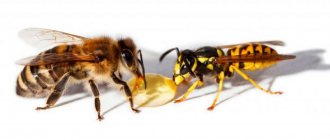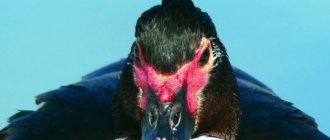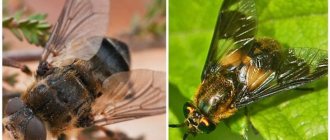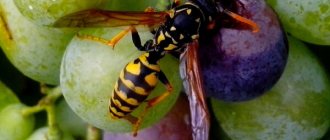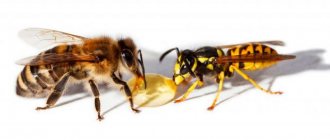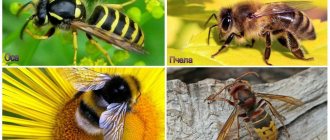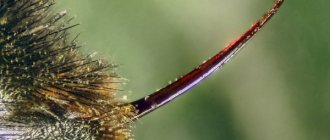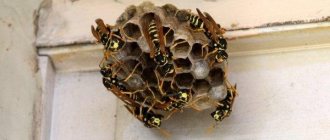With the onset of warm weather, almost all insects become active. Wasps and bees do not stand aside, reminding us of their existence in the natural environment, on the balconies of apartments, in city parks and squares, on personal plots. From the school curriculum, few people remember the difference between a wasp and a bee. Interest is sharply awakened at the sight of stinging insects and especially after their bites.
Types of bees and wasps: are there any that are very similar to each other?
For children and people far from science, most species of bees and wasps will seem similar. Mimicking species (flies, butterflies, beetles, etc.) can be distinguished separately. All these insects belong to the order Hymenoptera, and similarities are observed within it.
The need for imitation is determined for harmless insects by the desire to protect themselves: the colors, reminiscent of the integument of a wasp, are perceived as a message about the aggressiveness of the owner, the presence of deadly jaws and stings. The oral apparatus of wasps is capable of grinding wood into paper and allows them to obtain food of animal origin (for the most part, to kill other insects). Therefore, much greater similarity is observed in this direction (glass butterfly, hoverfly, short-winged fly).
Bees are more peaceful creatures . The activity of the family is aimed at producing honey on a larger scale than other species. This is facilitated by the restructuring of the jaw apparatus into a proboscis and fluffy fur on the integument of the body. Bees cope with predators together; they do not need to imitate wasps. Representatives of the species are at enmity with each other; a wasp can even fly into a bee hive while hunting.
Within the subfamilies of wasps, bees and bumblebees, more than 20 thousand species are distinguished. Representatives of the species are similar in their habits, lifestyle and appearance.
Color
You can identify the difference between a bee and a wasp visually by their appearance. The color of the bee is muted yellow with black stripes. The body is covered with hairs.
The wasp is distinguished by a smooth body without signs of hair, rich yellow and contrasting black stripes. The bright “robe” of the insect is noticeable from a great distance. But the wasp does not need thick hair, because collecting nectar is not its main business.
What function do they perform?
For humans, bees are a vital insect, capable of pollinating a third of the world's plant crops. Pollen transfer required:
- cucumbers;
- soy;
- kiwi;
- citrus;
- pumpkin;
- melon;
- cotton;
- coffee tree, etc.
In addition, alfalfa and clover used in livestock feeding depend on bees for their life cycle. Representatives of the family provide the production of wax, propolis and royal jelly. The British Beekeepers' Association has calculated the contribution of bees to the global economy. The work they do on the major plant species used for human food alone is equivalent to €130 billion. The amount does not include the production of honey and related products.
Bees also influence the biological diversity of ecosystems. The transfer of pollen on body hairs provides genetic diversity in plants. Phytocenoses cultivated by bees are capable of self-sustaining without human intervention.
Due to the aggressive nature of wasps, their functions are limited to the destruction of pests, including mole crickets, and indirect protection of weak insects (imitation of the striped colors of harmless species).
The peptide toxin mastoparan contained in wasp venom is capable of destroying living cells and tissues. The scientific community is trying to develop an analog synthetic substance that selectively affects cancer cells.
Wasp larvae as food reservoirs for adult insects
Interestingly, in times of famine, adult wasps belonging to collective species can use larvae as sources of food (more precisely, the nutrient fluids they secrete).
At each feeding, the adult passes chewed food to the larva, and in response it secretes saliva, which the feeder feasts on. Even if the adult wasp did not bring food, the larva will still share its secret with it. This phenomenon is called trophallaxis, and is a way to maintain the viability of an entire colony of insects during periods of prolonged rain or cold weather in the north.
The photo shows how an adult wasp feeds larvae:
Finally, the wasp larvae themselves are of gastronomic interest to many animals. Birds (for example, bee-eaters) willingly steal larvae from nests that are beginning to be built. Bears and honey badgers also enjoy destroying such nests.
And in Japan, there is a traditional dish called jibatinoko, which is wasp larvae boiled with sugar and soy sauce.
During the difficult war years, it was insects that allowed many Japanese not to die of hunger.
Appearance and body structure
The coloring of the bodies of both genera is black and yellow, designed to communicate the danger posed by the insect; only the shades and brightness of the colors differ. The body structure is characteristic of most representatives of Hymenoptera.
Wing structure
The flying apparatus of bees and wasps is represented by 2 pairs of membranous-leathery wings, with the first pair being longer than the second. The load during flight is redistributed to the thoracic region of the body, thanks to the attachment of the wings to the body using a chitinous structure.
Hemolymph is distributed along a tubular vein that passes from the body into an extensive network of segments on the wings. So these parts of the body participate in the metabolism of the insect body (i.e., these are not “dead” formations).
Body size and shape
The structure of representatives of both families includes the head, chest and abdomen. There is a subtle interception between the last parts of the body. In bees, the difference is less pronounced due to increased pubescence.
Working class wasps develop to a size of 1.4 cm, females of the family grow larger (up to 1.8 cm). Representatives of the aspen genus, hornets, can be up to 2-3 cm in length.
Bees are on average smaller than wasps, but the bodies of males can reach 1.4 cm, and the bodies of queens (females) up to 2 cm.
Sting
The sting of representatives of the bee family has many serrations and a knot at the tip, reminiscent of a saw or harpoon. The wasp sting has fewer teeth and no knot at the end. The wasp can sting repeatedly and often uses its jaws to attack.
Features of behavior
A bumblebee and a wasp are much less similar than a bee and a bumblebee. The behavior of insects is explained by their instinctive skills and type of food. Bees and bumblebees collect nectar from plants, thereby ensuring complete pollination of crops. Honey plants have a special sac in their structure in which they collect nectar, and then convert it into bee or bumblebee honey. Bumblebees are unique in that they wake up much earlier than other pollinators. They warm up their body in a special way and go on a flight.
Bee, bumblebee and wasp
Representatives of the wasp family feed on fruit juices, nectar, and honey. But for the development of larvae, protein food is required. For this reason, predators attack other insects and their larvae. They chew their insides, form small balls, and feed them to the larvae. In return they receive saliva, which is secreted by their cubs. There is a mutual exchange of food.
Interesting!
A wasp swarm periodically attacks bee colonies, destroying the hives in a few hours. They eat honey. There is also a claim that wasps eat bees. They attack weakened, sick insects, but once inside the hive, they paralyze everyone indiscriminately. They drag the captives to their nest and feed them to the larvae.
Since wasps are omnivores, they can often be found in the garden, yard, summer cottage, even in an apartment or house. They are attracted to sweet, sour, rotten meat and fish. Wasps fly in small flocks and keep a certain distance. Bees cluster together, but bumblebees prefer to fly alone.
Relation to the queen and hive
The queens of both genera are larger than the workers, are in the nest, and feed using the labor of the workers. The female bee is protected and protected by her family and spends the winter with all its members. The queen wasp does not have any special privileges; she hibernates alone. Both insects are always able to find their way to the hive, no matter how far they fly in search of pollen.
Lifestyle
There is also a difference between a bee and a wasp in their lifestyle. In nature, honey insects live in trees or rock crevices in honeycomb nests. The inside of their home is covered with wax.
Bees live in colonies that include a queen, workers and drones. Each of them performs its specific function. The queen breeds offspring, workers extract nectar and process it into honey, and drones inseminate the female and regulate the temperature inside the nest.
Unlike bees, the wasp prefers to settle in gardens, as well as near human habitation. These insects build nests under the roofs of houses and various buildings. They make their homes from chewed wood and grass. Wasps can be solitary or social, living in a family like bees.
Nutrition of bees and wasps
Wasps are omnivores, their diet may include:
- larvae and adults of insects;
- pieces of fish and meat;
- fruit pulp and juice;
- flower nectar.
During the process of evolution, wasps have developed certain food preferences that vary according to the stages of development of the individual. This feature made it possible to reduce competition within the species. For example, larvae of the wasp family are strict predators that feed on other larvae and parts of insects, which is actively used by gardeners to destroy pests.
Bees that leave large reserves of food for the winter prefer plant foods (linden, bird cherry, thyme, sage, etc.) and fruit syrups. Wild species do not spoil the harvest; insects require damage to the fruit cover to eat the fruit. For example, a passage gnawed out by a wasp. The bee climbs into it and drinks the juice (mainly choosing apples, pears and plums).
Differences in flight
If you compare a wasp, a bee, a bumblebee during the flight, you can also find significant differences.
Wasps make sudden movements and easily hover in the air. In an instant they can move from one place to another. During long-term observation, one can notice constant jerking movements and frequent changes in trajectory.
Bees fly more calmly and measuredly. They do not make sudden movements and try to land quickly. They do not create an annoying buzzing sound; it is more difficult to notice them by their sound than wasps.
Experts have long called the flight of a bumblebee an exception to the rules of aerodynamics. The furry specimen flies smoothly and slowly, creating a rather noticeable roar.
Bite difference
The wasp's aggressive instinct leads to the fact that the insect may attack first. Bees are peaceful, attack only in self-defense, stinging once (and some species are incapable of stinging). The bee sting is similar to a saw; it easily penetrates tissue, but gets stuck in it. The insect twitches, trying to fly away, as a result of which the process comes off with a small part of the abdomen and the bee dies after some time. First, a pulsation is felt in the wound - the poison continues to be pumped from the sting.
The wasp's venom is more toxic; after a bite, an allergic reaction immediately develops, swelling, redness and pain appear. An insect can sting up to 5 times at one time. In this case, the stinging needle is pulled out from the victim’s body according to the principle of a stretching thread.
Painful bite
It is believed that a wasp sting is more painful than a bee sting. This difference is due to the degree of toxicity of the poison. A bee sting causes a local inflammatory reaction and rarely leads to serious consequences (especially if you quickly remove the sting, wash the wound and take antihistamines).
External differences
External signs of a bee sting are redness of the skin with a white dot in the center - this is where the sting enters. There is sharp pain and swelling develops in the area of the skin puncture.
The type of wasp sting differs from a bee sting in the absence of a white dot, i.e. stings in the wound and more pronounced swelling at the site of injury.
Life expectancy of a bee after a sting
An insect can live from a few minutes to a day and a half, because... the tip comes off along with part of the internal organs of the abdominal region. The exact length of life remaining will depend on the extent of the damage.
Stages of development
Wasps lay their larvae in such a way that they cannot fall out of the nest. This is also prevented by the thick body, which clogs the honeycomb like a cork in a bottle. The adult, after completing the pupation process, simply straightens and climbs out. The female uses a special substance to attach her egg to the honeycomb, which allows the small larva to remain safe. After she gets fat, she is kept in the nest by her large body mass and lack of waist.
The life cycle of the larva lasts about two weeks. Then a thick cocoon forms around it and the pupation stage begins. After 10-14 days, this stage also ends - an adult is born.
Wasps are not particularly fond of children. If difficult times of hunger come, adult insects eat the contents of the cocoons.
There is an interesting feature in the life of these pests. When the adult cannot obtain insects for food, the larva secretes nutrients to support the life of the colony members. In this way the number of individuals in the nest is regulated. This usually happens during cold weather and prolonged rainy weather.
If the homeowner decides to finally deal with the annoying and dangerous invaders, then he should take into account the peculiarities of the development of the larvae. Young wild wasps fly out of the nest a few weeks after the larvae emerge. This is necessary to determine the timing of re-treatment of the colony with chemicals. Only after disinfestation has been carried out 2-3 times can it be said that all insects have been destroyed.
Found a hive of wild wasps - prepare for bites
Many people believe that wasps attack only if they are provoked, for example, by hitting the nest or trying to catch an individual with your hands. But this is a misconception. Insects defend their territory; at the slightest visible danger, they fiercely defend their offspring and the hive. And if tactile contact with a pest accidentally occurs, it will immediately attack. Unfortunately, a wild wasp sting can cause serious harm to health, especially if the attack is widespread.
In addition to the fact that they can carry E. coli, you should be wary of the following troubles:
- Severe pain at the site of the bite.
- Severe tissue swelling (allergies)
- Increased body temperature.
- Obstruction of the airways.
- Tearing.
- Fever and weakness.
- Anaphylactic shock.
There are cases when a person simply died after being bitten by these dangerous insects, especially their overseas “brothers”. The thing is that wasps, for example hornets, release strong poison through their sting when they pierce the skin. Of course, they don’t want to kill us, it’s just that in the wild this is how they paralyze their prey. To alleviate the condition of the bitten person as much as possible, he is given an antihistamine and pain reliever.
Diet
Harmless and sluggish-looking wasp larvae are insectivores. They themselves are not able to hunt and get their own food, but they willingly eat parts of insects that are delivered to them by adults.
Depending on the species, there are differences between individuals:
- feed themselves;
- feed on social wasps.
The larvae of European and Asian hornets cannot feed without the help of adults and cannot actively move inside the nest. They only slightly rotate their heads looking out of the honeycomb. The diet of adult insects includes flower nectar, sweet berry and fruit juice. And the younger generation prefers animal food, which is chewed for them by wasps and delivered directly to the nest. The excrement remains inside the cocoon until it completely transforms into an adult insect. Having spread its wings, the young individual leaves the nest, and the workers remove the secretions.
After the autumn fertilization of the female, wild male wasps die. In the vast majority of cases, females prepare small nests in the form of a depression in the ground or a paper shelter that is attached to walls or trees. The adult attacks and paralyzes any insect with poison and delivers it to its shelter. This is where the wasp egg is laid. After hatching, the individual begins to feed on insects. She does this in such a way that the “food” remains viable for a long time.
What does a wasp larva eat:
- caterpillars;
- butterflies;
- cockroaches;
- slugs;
- bees;
- spiders;
- little mice;
- small lizards.
Each species prefers different types of insects for laying eggs. Some eat only spiders, others like bedbugs. Some wasps lay eggs directly into a living insect. As the larvae mature, they eat their prey from the inside. Over time, the insect dies, and the young, fully formed individual climbs out.
First aid for a bee or wasp sting
Trying to find the sting after a bite, further damaging the skin with your nails, is not worth it; you can cause an infection. The tip is visible to the naked eye if it remains. In this case, you should carefully remove it.
If no sting is observed, you can proceed to rinsing the wound with clean water and further treatment (alcohol or hydrogen peroxide is suitable for this). It is necessary to take antihistamines to avoid possible complications.
